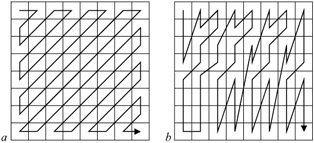8.3 How does the MPEG-2 video encoder differ from MPEG-1?
8.3 How does the MPEG-2 video encoder differ from MPEG-1?
8.3.1 Major differences
From the profile and level we see that the picture resolutions in MPEG-2 can vary from SIF (352 × 288 × 25 or 30) to HDTV with 1920 x 1250 x 60. Moreover, most of these pictures are interlaced, whereas in MPEG-1 pictures are noninterlaced (progressive). Coding of interlaced pictures is the first difference between the two coding schemes.
In the MPEG-2 standard, combinations of various picture formats and the interlaced/progressive option create a new range of macroblock types. Although each macroblock in a progressive mode has six blocks in the 4:2:0 format, the number of blocks in the 4:4:4 image format is 12. Also, the dimensions of the unit of blocks used for motion estimation/compensation can change. In the interlaced pictures, since the number of lines per field is half the number of lines per frame then, with equal horizontal and vertical resolutions, for motion estimation it might be appropriate to choose blocks of 16 x 8, i.e. 16 pixels over eight lines. These types of submacroblock have half the number of blocks of the progressive mode.
The second significant difference between the MPEG-1 and the MPEG-2 video encoders is the new function of scalability. The scalable modes of MPEG-2 are intended to offer interoperability among different services or to accommodate the varying capabilities of different receivers and networks upon which a single service may operate. They allow a receiver to decode a subset of the full bit stream in order to display an image sequence at a reduced quality, spatial and temporal resolution.
8.3.2 Minor differences
Apart from the two major distinctions there are some other minor differences, which have been introduced to increase the coding efficiency of MPEG-2. They are again due to the picture interlacing used in MPEG-2. The first one is the scanning order of DCT coefficients. In MPEG-1, like H.261, zigzag scanning is used. MPEG-2 has the choice of using alternate scan, as shown in Figure 8.3b. For interlaced pictures, since the vertical correlation in the field pictures is greatly reduced, should field prediction be used, an alternate scan may perform better than a zigzag scan.

Figure 8.3: Two types of scanning method (a zigzag scan) (b alternate scan)
The second minor difference is on the nature of quantisation of the DCT coefficients. MPEG-2 supports both linear and nonlinear quantisation of the DCT coefficients. The nonlinear quantisation increases the precision of quantisation at high bit rates by employing lower quantiser scale values. This improves picture quality at low contrast areas. At lower bit rates, where larger step sizes are needed, again the nonlinear behaviour of the quantiser provides a larger dynamic range for quantisation of the coefficients.
8.3.3 MPEG-1 and MPEG-2 syntax differences
The IDCT mismatch control in MPEG-1 is slightly different from that in MPEG-2. After the inverse quantisation process of the DCT coefficients, the MPEG-1 standard requires that all the nonzero coefficients are added with 1 or -1. In the MPEG-2 standard, only the last coefficient need be added with 1 or -1 provided that the sum of all coefficients is even after inverse quantisation. Another significant variance is the run level values. In MPEG-1, those that cannot be coded with a variable length code (VLC) are coded with the escape code, followed by either a 14-bit or 22-bit fixed length coding (FLC), whereas for MPEG-2 they are followed by an 18-bit FLC.
The constraint parameter flag mechanism in MPEG-1 has been replaced by the profile and level structures in MPEG-2. The additional chroma formats (4:2:2 and 4:4:4) and the interlaced related operations (field prediction and scalable coding modes) make MPEG-2 bit stream syntax different from that of MPEG-1.
The concept of the group of pictures (GOP) layer is slightly different. GOP in MPEG-2 may indicate that certain B-pictures at the beginning of an edited sequence comprise a broken link which occurs if the forward reference picture needed to predict the current B-pictures is removed from the bit stream by an editing process. It is an optional structure for MPEG-2 but mandatory for MPEG-1. The final point is that slices in MPEG-2 must always start and end on the same horizontal row of macroblocks. This is to assist the implementations in which the decoding process is split into some parallel operations along horizontal strips within the same pictures.
Although these differences may make direct decoding of the MPEG-1 bit stream by an MPEG-2 decoder infeasible, the fundamentals of video coding in the two codecs remain the same. In fact, as we mentioned, there is a need for backward compatibility, such that the MPEG-2 decoder should be able to decode the MPEG-1 encoded bit stream. Thus MPEG-1 is a subset of MPEG-2. They employ the same concept of a group of pictures, and the interlaced field pictures now become I, P and B-fields, and all the macroblock types have to be identified as field or frame based. Therefore in describing the MPEG-2 video codec, we will avoid repeating what has already been said about MPEG-1 in Chapter 7. Instead we concentrate on those parts which have risen due to interlacing and scalability of MPEG-2. However, for information on the difference between MPEG-1 and MPEG-2 refer to [7].
EAN: 2147483647
Pages: 148